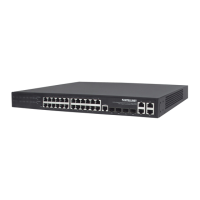• Blocking – the port is blocked from forwarding or receiving packets
• Listening – the port is waiting to receive BPDU packets that may tell the port to go back to the
blocking state
• Learning – the port is adding addresses to its forwarding database, but not yet forwarding packets
• Forwarding – the port is forwarding packets
• Disabled – the port only responds to network management messages and must return to the
blocking state rst
A port transitions from one state to another as follows:
• From initialization (switch boot) to blocking
• From blocking to listening or to disabled
• From listening to learning or to disabled
• From learning to forwarding or to disabled
• From forwarding to disabled
• From disabled to blocking
It’s possible to modify each port state by using management software. When you enable STP, every port
on every switch in the network goes through the blocking state and then transitions through the states of
listening and learning at power up. If properly congured, each port stabilizes to the forwarding or blocking
state. No packets (except BPDUs) are forwarded from or received by STP enabled ports, until the forwarding
state is enabled for that port.
The switch allows for two levels of operation: the switch level and the port level. The switch level forms a
spanning tree consisting of links between one or more switches. The port level constructs a spanning tree
consisting of groups of one or more ports. The STP operates in much the same way for both levels.
MSTP REGION
Item Description
MSTP Region
Conguration
Each switch running MST in the network has a single MST conguration that
consists of these two attributes:
1. Region name
a. An alphanumeric conguration name
2. Revision Level
Instance Mapping A table that associates each of the potential 4096 VLAN IDs to a given instance.

